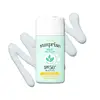What's inside
What's inside
 Key Ingredients
Key Ingredients

 Benefits
Benefits

 Concerns
Concerns

 Ingredients Side-by-side
Ingredients Side-by-side

Homosalate 10%
Skin ConditioningOctocrylene 7.5%
UV AbsorberEthylhexyl Salicylate 5%
UV AbsorberBenzophenone-3 5%
UV AbsorberAcrylates/Dimethicone Methacrylate Copolymer 3%
EmollientAscorbic Acid
AntioxidantBHT
AntioxidantBisabolol
MaskingButylene Glycol
HumectantC12-15 Alkyl Benzoate
AntimicrobialCamellia Oleifera Leaf Extract
AstringentCaprylyl Glycol
EmollientCetyl Dimethicone
EmollientChlorphenesin
AntimicrobialCyclopentasiloxane
EmollientDiethylhexyl 2,6-Naphthalate
EmollientDisodium EDTA
Ethylhexylglycerin
Skin ConditioningMannan
Neopentyl Glycol Diheptanoate
EmollientPantothenic Acid
Skin ConditioningParfum
MaskingPentylene Glycol
Skin ConditioningPhenoxyethanol
PreservativePolyester-7
Skin ConditioningPolymethyl Methacrylate
Portulaca Oleracea Extract
Skin ConditioningRetinyl Palmitate
Skin ConditioningSilica
AbrasiveSteareth-100
Gel FormingSteareth-2
EmulsifyingStyrene/Acrylates Copolymer
Tocopheryl Acetate
AntioxidantWater
Skin ConditioningXanthan Gum
EmulsifyingHomosalate 10%, Octocrylene 7.5%, Ethylhexyl Salicylate 5%, Benzophenone-3 5%, Acrylates/Dimethicone Methacrylate Copolymer 3%, Ascorbic Acid, BHT, Bisabolol, Butylene Glycol, C12-15 Alkyl Benzoate, Camellia Oleifera Leaf Extract, Caprylyl Glycol, Cetyl Dimethicone, Chlorphenesin, Cyclopentasiloxane, Diethylhexyl 2,6-Naphthalate, Disodium EDTA, Ethylhexylglycerin, Mannan, Neopentyl Glycol Diheptanoate, Pantothenic Acid, Parfum, Pentylene Glycol, Phenoxyethanol, Polyester-7, Polymethyl Methacrylate, Portulaca Oleracea Extract, Retinyl Palmitate, Silica, Steareth-100, Steareth-2, Styrene/Acrylates Copolymer, Tocopheryl Acetate, Water, Xanthan Gum
Water
Skin ConditioningZinc Oxide
Cosmetic ColorantDisiloxane
Skin ConditioningCyclohexasiloxane
EmollientButyloctyl Salicylate
Skin ConditioningPropylene Glycol Dicaprylate
EmollientPropanediol
SolventMethyl Trimethicone
Skin ConditioningMethyl Methacrylate Crosspolymer
Triethoxycaprylylsilane
Lauryl Polyglyceryl-3 Polydimethylsiloxyethyl Dimethicone
Skin ConditioningSodium Chloride
Masking1,2-Hexanediol
Skin ConditioningPolymethylsilsesquioxane
Polyglyceryl-3 Polydimethylsiloxyethyl Dimethicone
Skin ConditioningParfum
MaskingCaprylyl Glycol
EmollientGlyceryl Caprylate
EmollientEthylhexylglycerin
Skin ConditioningSodium Hyaluronate
HumectantHelianthus Annuus Seed Oil
EmollientAdansonia Digitata Seed Oil
EmollientButylene Glycol
HumectantTocopherol
AntioxidantOpuntia Ficus-Indica Extract
Skin ConditioningPhenoxyethanol
PreservativeAloe Barbadensis Leaf Juice
Skin ConditioningCitric Acid
BufferingPotassium Sorbate
PreservativeCarex Humillis Root Extract
Skin ConditioningSodium Benzoate
MaskingMalpighia Emarginata Fruit Extract
Skin ConditioningEuterpe Oleracea Fruit Extract
Terminalia Ferdinandiana Fruit Extract
AntioxidantWater, Zinc Oxide, Disiloxane, Cyclohexasiloxane, Butyloctyl Salicylate, Propylene Glycol Dicaprylate, Propanediol, Methyl Trimethicone, Methyl Methacrylate Crosspolymer, Triethoxycaprylylsilane, Lauryl Polyglyceryl-3 Polydimethylsiloxyethyl Dimethicone, Sodium Chloride, 1,2-Hexanediol, Polymethylsilsesquioxane, Polyglyceryl-3 Polydimethylsiloxyethyl Dimethicone, Parfum, Caprylyl Glycol, Glyceryl Caprylate, Ethylhexylglycerin, Sodium Hyaluronate, Helianthus Annuus Seed Oil, Adansonia Digitata Seed Oil, Butylene Glycol, Tocopherol, Opuntia Ficus-Indica Extract, Phenoxyethanol, Aloe Barbadensis Leaf Juice, Citric Acid, Potassium Sorbate, Carex Humillis Root Extract, Sodium Benzoate, Malpighia Emarginata Fruit Extract, Euterpe Oleracea Fruit Extract, Terminalia Ferdinandiana Fruit Extract
 Reviews
Reviews

Ingredients Explained
These ingredients are found in both products.
Ingredients higher up in an ingredient list are typically present in a larger amount.
Butylene Glycol (or BG) is used within cosmetic products for a few different reasons:
Overall, Butylene Glycol is a safe and well-rounded ingredient that works well with other ingredients.
Though this ingredient works well with most skin types, some people with sensitive skin may experience a reaction such as allergic rashes, closed comedones, or itchiness.
Learn more about Butylene GlycolCaprylyl Glycol is a humectant and emollient, meaning it attracts and preserves moisture.
It is a common ingredient in many products, especially those designed to hydrate skin. The primary benefits are retaining moisture, skin softening, and promoting a healthy skin barrier.
Though Caprylyl Glycol is an alcohol derived from fatty acids, it is not the kind that can dry out skin.
This ingredient is also used as a preservative to extend the life of products. It has slight antimicrobial properties.
Learn more about Caprylyl GlycolEthylhexylglycerin (we can't pronounce this either) is commonly used as a preservative and skin softener. It is derived from glyceryl.
You might see Ethylhexylglycerin often paired with other preservatives such as phenoxyethanol. Ethylhexylglycerin has been found to increase the effectiveness of these other preservatives.
Parfum is a catch-all term for an ingredient or more that is used to give a scent to products.
Also called "fragrance", this ingredient can be a blend of hundreds of chemicals or plant oils. This means every product with "fragrance" or "parfum" in the ingredients list is a different mixture.
For instance, Habanolide is a proprietary trade name for a specific aroma chemical. When used as a fragrance ingredient in cosmetics, most aroma chemicals fall under the broad labeling category of “FRAGRANCE” or “PARFUM” according to EU and US regulations.
The term 'parfum' or 'fragrance' is not regulated in many countries. In many cases, it is up to the brand to define this term.
For instance, many brands choose to label themselves as "fragrance-free" because they are not using synthetic fragrances. However, their products may still contain ingredients such as essential oils that are considered a fragrance by INCI standards.
One example is Calendula flower extract. Calendula is an essential oil that still imparts a scent or 'fragrance'.
Depending on the blend, the ingredients in the mixture can cause allergies and sensitivities on the skin. Some ingredients that are known EU allergens include linalool and citronellol.
Parfum can also be used to mask or cover an unpleasant scent.
The bottom line is: not all fragrances/parfum/ingredients are created equally. If you are worried about fragrances, we recommend taking a closer look at an ingredient. And of course, we always recommend speaking with a professional.
Learn more about ParfumPhenoxyethanol is a preservative that has germicide, antimicrobial, and aromatic properties. Studies show that phenoxyethanol can prevent microbial growth. By itself, it has a scent that is similar to that of a rose.
It's often used in formulations along with Caprylyl Glycol to preserve the shelf life of products.
Water. It's the most common cosmetic ingredient of all. You'll usually see it at the top of ingredient lists, meaning that it makes up the largest part of the product.
So why is it so popular? Water most often acts as a solvent - this means that it helps dissolve other ingredients into the formulation.
You'll also recognize water as that liquid we all need to stay alive. If you see this, drink a glass of water. Stay hydrated!
Learn more about Water